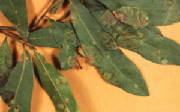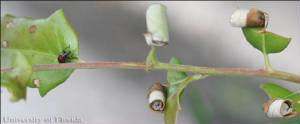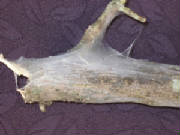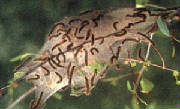|
|
 |
|
Gardening Blog
|
 |
|
|
Friday, April 15, 2011
Oak Potpourri
We have a lot of Oak trees in Pinellas County
and there are several problems that you may notice in the spring or throughout the year. Most are not life
threatening for the oak and are only curiosities, but at least one can be a symptom of deeper problems. 
Oak leaf blister (Taphrina caerulescens) is a fungus that commonly attacks
Laurel Oaks in the spring when we have had cooler and wetter than normal weather. This fungal pathogen
causes raised or wrinkled blisters on new leaves that are initially pale green, but will turn brown later in the season. It
is unsightly, but usually not treated with fungicides unless there is a severe infection on a newly planted young tree. Rake
and discard fallen leaves from under infected trees to reduce the disease organisms for the following year. 
The leaf rolling weevil (Homoeolabus analis) attacks oaks in our area by creating individual nests (nidi) for its eggs using leaves
rolled into a tight bundle that looks like a miniature egg roll. The bundle is then either cut away to
fall to the ground, or it remains attached to the leaf base on the tree. I find these strange nests scattered
on my wooden deck under my live oak tree. The adult
weevils feed by chewing small holes in the leaves in addition to the leaves that are damaged by construction of the nidi.
The weevils do not cause significant damage to trees, so control is not necessary.

Psocids (Archipsocus
nomas)
are small insects that congregate on tree trunks or branches. The whole group of insects are often covered with a tight silk
webbing, which could be the first sign noticed. The insects are quite small (about ¼ inch), and the adults have wings.
They cause no harm to the trees, instead they feed on debris such as lichens, fungi, and pollen found on the bark.

There are a number
of different caterpillars that attack oaks, including: eastern tent, fall webworm, tussock moth, and leaf
rollers. Look for caterpillars hanging from silk strands, grouped in webs, or crawling up tree trunks shortly after leaf emergence
in the spring. Caterpillars feed on the foliage, causing holes or jagged edges in leaves and the pellets of frass (fecal material)
can be seen on surfaces underneath trees. Eastern tent caterpillars make webs in the crotches of branches.
Other types of caterpillars may be identified by color patterns and by unique tufts of hairs. Natural enemies
and unfavorable weather conditions usually keep populations low. Outbreaks do occur, but usually last only one to two years.
Remove and destroy tents of eastern tent caterpillars when first noticed.

Insect-induced galls occur in many forms, colors and shapes. They may
be hair-like projections, spheres, rosettes or woody swellings and can occur on leaves or twigs or branches. The malformed
plant tissue, or gall, forms in response to egg-laying or feeding by wasps, midges, mites, moths, aphids or beetles. The young
insects develop inside, but cause little or no damage to the tree. Small exit holes on the outside of the gall indicate that
the insects have already emerged, but the gall remains.
There are many of different borers that affect
oaks. They can be detected by looking for symptoms such as foliage discoloration, wilting, branch dieback,
and small holes in the trunk of the tree. You could also observe woodpeckers feeding on the bark. Examination
of the trunk may reveal sap staining and sawdust or pellets on the bark. By carefully removing the bark around the borer holes,
you can see the tunneling caused by the larval stages of the beetles. Trees affected by borers are generally
weakened or wounded by some other factor such as root rot, soil disturbance, drought, flooding, or physical injuries to trunk
or branches. To avoid infestations, keep trees healthy. Remove and destroy severely infested trees, or
prune out dead and dying branches. Once a tree is infested, little can be done. An arborist can temporarily protect other
nearby trees with approved insecticides applied to the trunk from spring to fall.
All
pictures are from University of Florida/IFAS sources.
|
|
To subscribe to this blog - click on XML icon.
|
 |
|
|
|
 |
|
|
Pampered Gardeners LLC * Oldsmar, FL * USA * Phone: 727 483-3783 * pam@pamperedgardeners.com
|
|
|
 |

